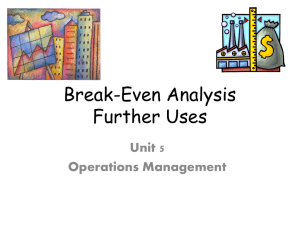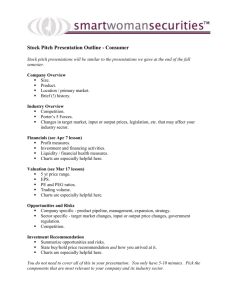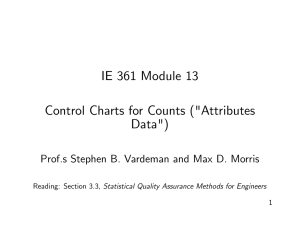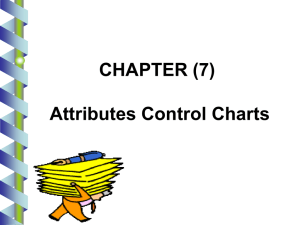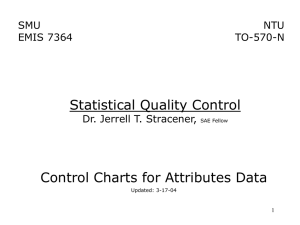INTRODUCTION TO ENGINEERING ECONOMICS Chapter 1
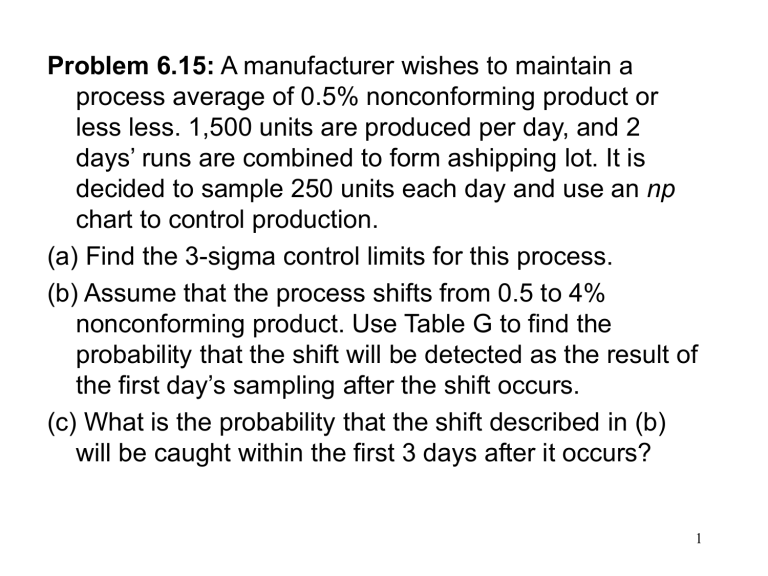
Problem 6.15: A manufacturer wishes to maintain a process average of 0.5% nonconforming product or less less. 1,500 units are produced per day, and 2 days’ runs are combined to form ashipping lot. It is decided to sample 250 units each day and use an np chart to control production.
(a) Find the 3-sigma control limits for this process.
(b) Assume that the process shifts from 0.5 to 4% nonconforming product. Use Table G to find the probability that the shift will be detected as the result of the first day’s sampling after the shift occurs.
(c) What is the probability that the shift described in (b) will be caught within the first 3 days after it occurs?
1
The Control Chart for Nonconformities
The c and u charts
• Defective and defect
– A defective article is the one that fails to conform to some specification.
– Each instance of the article’s lack of conformity to specifications is a defect
– A defective article may have one or more defects
2
The Control Chart for Nonconformities
The c and u charts
• The np and c charts
– Both the charts apply to total counts
– The np chart applies to the total number of defectives in samples of constant size
– The c chart applies to the total number of defects in samples of constant size
• The u chart
– If the sample size varies, the u chart for the number of defects per unit may be used
3
The Control Chart for Nonconformities
The c and u charts
• The 3-sigma limits for the c chart are:
UCL c
c
3 c , LCL c
c
3 c
mean and c
0 is the standard mean.
4
The Control Chart for Nonconformities
The c and u charts
• As the Poisson distribution is not symmetrical, the upper and lower 3-sigma limits do not correspond to equal probabilities of a point on the control chart falling outside limits (See Section 7.7). To avoid the problem with asymmetry, the use of 0.995 and 0.005 limits has been favored
• If the distribution does not follow Poisson law, actual limit obtained from the formula
5
The Control Chart for Nonconformities
The c and u charts
• The 3-sigma limits for the u chart, for sample i
UCL u
u
3 u n i
, LCL u
u
3 u n i u mean and u
0
n
• units, number of square feet of area, etc.
u n
6
Problem 7.3: Use Table G, App. 3, to find 0.995 and
0.005 probability limits for a c chart when when
c
= 12.0
c
= 5.8. Also
7
Problem 7.8: A c chart is used to monitor the number of surface imperfections on sheets of photographic film.
(a) Find the 3-sigma control limits for this process.
(b) Use Table G to determine the probability that a point will fall outside these control limits while the process is actually operating at a
c of 2.6.
(c) If the process average shifts to 4.8, what is the probability of not detecting the shift on the first sample taken after the shift occurs?
8
Problem 7.16: A shop uses a control chart on maintenance workers based on maintenance errors per standard worker-hour. For each worker, a random sample of 5 items is taken daily and the statistic c / n is plotted on the worker’s control chart where c is the count of errors found in 5 assemblies and n is the total worker-hours required for the 5 assemblies.
(a) After the first 4 weeks, the record for one worker is
c =22 and
n =54. Determine the central line and the
3-sigma control limits.
(b) On a certain day during the 4-week period, the worker makes 2 errors in 4,3 standard worker-hour. Determine if the point for this day falls within control limits.
9
Reading and Exercises
• Chapter 6:
– pp. 223-234 (Sections 6.1-6.6)
– Problems 6.6, 6.10, 6.16
– Note for Problems 6.6 and 6.10: p
0 is obtained by eliminating out-of-control points and computing mean value with only the in-control points
• Chapter 7:
– pp. 260-265, 268-275 (Sections 7.1-7.3,7.5-7.7)
– Problems 7.4, 7.11, 7.15, 7.26
10



